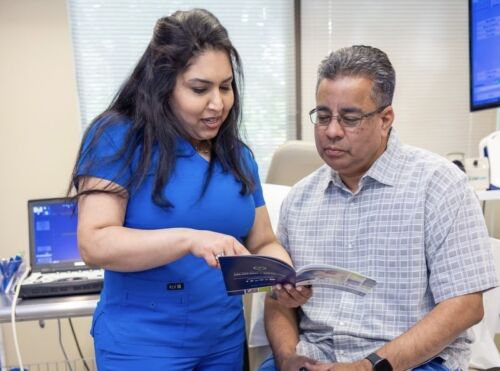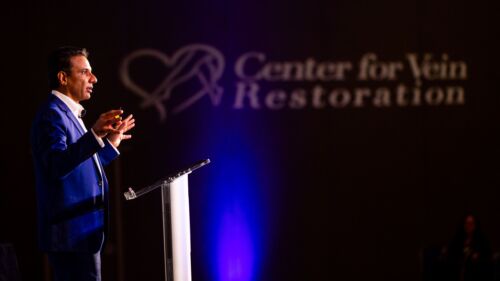Swelling is a common symptom of varicose veins. But why does leg swelling happen?
In addition to twisted, bulging veins on the legs and feet, swelling often accompanies varicose veins. The swelling is not only unsightly but also causes a sensation of heaviness and achiness in the leg. Swelling may be the most challenging symptom for many people with varicose veins.
As the swelling progresses, patients often become self-conscious and may try to hide their legs under clothing. But with simple lifestyle changes, at-home remedies, and medical procedures, you can reduce the discomfort and proudly show off your legs again!
But first, let’s look at the reason behind the swelling.
How do varicose veins lead to swelling?
Swelling is a side effect of venous insufficiency, the root cause of varicose veins. Inside your leg veins, tiny valves help pump blood back to the heart. When the valves lose their strength and elasticity, blood flows backward and pools within the vein.
As blood pressure increases, the vein wall stretches beyond its limit and a swollen varicose vein forms. This pressure further pushes excess fluid to leak out into the surrounding tissues, leading to swelling, skin discoloration, a feeling of heaviness, or a burning sensation.
Excessive swelling can cause other complications, such as slow-healing skin ulcers. Your skin needs nutrient-rich blood to fight infection and heal. When circulation is blocked as blood collects in the veins, your skin doesn’t receive the vital nutrients it needs to fight bacteria and repair itself. A vein specialist should check any skin changes around a varicose vein to prevent an infection.
Swelling is also a sign of possible deep vein thrombosis (DVT), also known as a blood clot in the leg. Swelling, along with pain and reddish-color skin, may indicate DVT, which can become dangerous if the clot breaks free and travels to the lungs.
How to stop the swelling
Getting rid of the swelling starts with addressing your varicose veins. The board-certified vein doctors at Center for Vein Restoration offer many minimally invasive outpatient surgical treatments for diseased veins. For example, sclerotherapy involves sealing the diseased vein shut with a sclerosant solution. Other procedures such as laser or radiofrequency ablation use heat to collapse the affected vein. In both cases, blood then reroutes to healthier veins as the body absorbs the destroyed vein. Patients can return to their regular routine quickly with few restrictions.
Another popular method for treating problem veins is ambulatory phlebectomy. During this procedure, the doctor removes the vein through two tiny incisions.
You can relieve the swelling with some home remedies, too. While only medical procedures will permanently eliminate your varicose veins, these remedies can temporarily relieve your discomfort. Compression stockings gently squeeze the calf muscles and help push blood through the veins. You can also reverse the backup of blood in your veins by elevating your legs for as little as 15 minutes a day. Your swelling should go down as the blood empties from the vein and flows back to the heart.
Don’t live with swollen veins!
Center for Vein Restoration (CVR) operates two full-care offices in Austin, Texas, led by Aditya Gupta, MD, RPVI, DABVLM. Dr. Gupta is not only board-certified in Internal Medicine and Venous and Lymphatic Medicine but is also an expert in vascular interpretation. Dr. Gupta can diagnose and provide a tailored plan to treat your varicose veins so you don’t have to live with swollen veins ever again. Contact Dr. Gupta or one of CVR’s 100+ locations for a consultation.
11111 Research Boulevard
Suite 400
Austin, Texas 78759
7900 Farm to Market Road 1826
Building 1, Suite 170
Austin, TX 78737

 About Vein Disease
About Vein Disease
 Spider Veins
Spider Veins
 Varicose Veins
Varicose Veins
 Vein Disease Treatments
Vein Disease Treatments
 Treating Spider Veins
Treating Spider Veins
 Treating Varicose Veins
Treating Varicose Veins
 About Us
About Us
 Patient Resources
Patient Resources
 Physician Resources
Physician Resources


